Precipitation Variations in China’s Altay Mountains Detected from Tree Rings Dating Back to AD 1615
Abstract
1. Introduction
2. Materials and Methods
2.1. The Study Region and Sampling
2.2. Tree Ring Width Chronology
2.3. Meteorological Data and Statistical Analysis
3. Results
3.1. Climate Response Analysis
3.2. February–October Precipitation Reconstruction
4. Discussion
4.1. Regional-Scale Precipitation Signals
4.2. Climate–Growth Response
4.3. The Influence of North Arctic Oscillation Westerlies
4.4. Other Synoptic Influence Mechanisms of Precipitation Variation
5. Conclusions
Author Contributions
Funding
Data Availability Statement
Acknowledgments
Conflicts of Interest
References
- Popa, I.; Kern, Z. Long-term summer temperature reconstruction inferred from tree-ring records from the Eastern Carpathians. Clim. Dyn. 2009, 32, 1107–1117. [Google Scholar] [CrossRef]
- Díaz, S.C.; Touchan, R.; Swetnam, T.W. A tree-ring reconstruction of past precipitation for Baja California Sur, Mexico. Int. J. Climatol. J. R. Meteorol. Soc. 2001, 21, 1007–1019. [Google Scholar] [CrossRef]
- Liang, E.; Liu, X.; Yuan, Y.; Qin, N.; Fang, X.; Huang, L.; Huang, L.; Zhu, H.; Wang, L.; Shao, X. The 1920s drought recorded by tree rings and historical documents in the semi-arid and arid areas of northern China. Clim. Change 2006, 79, 403–432. [Google Scholar] [CrossRef]
- Wunder, J.; Fowler, A.M.; Cook, E.R.; Pirie, M.; McCloskey, S.P. On the influence of tree size on the climate–growth relationship of New Zealand kauri (Agathis australis): Insights from annual, monthly and daily growth patterns. Trees 2013, 27, 937–948. [Google Scholar] [CrossRef]
- Sangüesa-Barreda, G.; Camarero, J.J.; Esper, J.; Galván, J.D.; Büntgen, U. A millennium-long perspective on high-elevation pine recruitment in the Spanish central Pyrenees. Can. J. For. Res. 2018, 48, 1108–1113. [Google Scholar] [CrossRef]
- Uusitalo, J.; Arppe, L.; Hackman, T.; Helama, S.; Kovaltsov, G.; Mielikäinen, K.; Oinonen, M. Solar superstorm of AD 774 recorded subannually by Arctic tree rings. Nat. Commun. 2018, 9, 3495. [Google Scholar] [CrossRef]
- Shi, C.; Daux, V.; Li, Z.; Wu, X.; Fan, T.; Ma, Q.; Wu, X.; Tian, H.; Carre, M.; Ji, D.; et al. The response of relative humidity to centennial-scale warming over the southeastern Tibetan Plateau inferred from tree-ring width chronologies. Clim. Dyn. 2018, 51, 3735–3746. [Google Scholar] [CrossRef]
- Peng, D.; Zhou, T.; Zhang, L. Moisture sources associated with precipitation during dry and wet seasons over Central Asia. J. Clim. 2020, 33, 10755–10771. [Google Scholar] [CrossRef]
- Knorre, A.A.; Kirdyanov, A.V.; Vaganov, E.A. Climatically induced interannual variability in aboveground production in forest-tundra and northern taiga of central Siberia. Oecologia 2006, 147, 86–95. [Google Scholar] [CrossRef]
- Xu, G.; Liu, X.; Qin, D.; Chen, T.; Wang, W.; Wu, G.; Sun, W.; An, W.; Zeng, X. Relative humidity reconstruction for northwestern China’s Altay Mountains using tree-ring δ 18 O. Chin. Sci. Bull. 2014, 59, 190–200. [Google Scholar] [CrossRef]
- Chen, F.; Yuan, Y.J.; Wei, W.S.; Zhang, T.W.; Shang, H.M.; Zhang, R. Precipitation reconstruction for the southern Altay Mountains (China) from tree rings of Siberian spruce, reveals recent wetting trend. Dendrochronologia 2014, 32, 266–272. [Google Scholar] [CrossRef]
- Zhang, T.; Yuan, Y.; Chen, F.; Yu, S.; Zhang, R.; Qin, L.; Jiang, S. Reconstruction of hydrological changes based on tree-ring data of the Haba River, northwestern China. J. Arid Land 2018, 10, 53–67. [Google Scholar] [CrossRef]
- Jiang, S.; Zhang, T.; Yuan, Y.; Yu, S.; Shang, H.; Zhang, R. Drought reconstruction based on tree-ring earlywood of Picea obovata Ledeb. for the southern Altay Mountains. Geogr. Ann. Ser. A Phys. Geogr. 2020, 102, 267–286. [Google Scholar] [CrossRef]
- Fritts, H.C. Tree Rings and Climate; Academic Press: London, UK, 1976; p. 567. [Google Scholar]
- Cook, E.R. Bootstrap confidence intervals for red spruce ring-width chronologies and an assessment of age-related bias in recent growth trends. Can. J. For. Res. 1990, 20, 1326–1331. [Google Scholar] [CrossRef]
- Holmes, R.L. Computer-assisted quality control in tree-ring dating and measurement. Tree-Ring Bull. 1983, 43, 69–78. [Google Scholar]
- Cook, E.R. A Time Series Analysis Approach to Tree Ring Standardization (Dendrochronology, Forestry, Dendroclimatology, Autoregressive Process). Ph.D. Thesis, The University of Arizona, Tucson, AZ, USA, 1985. [Google Scholar]
- Cook, E.R.; Kairiukstis, L.A. (Eds.) Methods of Dendrochronology: Applications in the Environmental Sciences; Springer Science Business Media: Berlin/Heidelberg, Germany, 2013. [Google Scholar]
- Wigley, T.M.; Briffa, K.R.; Jones, P.D. On the average value of correlated time series, with applications in dendroclimatology and hydrometeorology. J. Appl. Meteorol. Clim. 1984, 23, 201–213. [Google Scholar] [CrossRef]
- Mann, M.E.; Lees, J.M. Robust estimation of background noise and signal detection in climatic time series. Clim. Change 1996, 33, 409–445. [Google Scholar] [CrossRef]
- Torrence, C.; Compo, G.P. A practical guide to wavelet analysis. Bull. Am. Meteorol. Soc. 1998, 79, 61–78. [Google Scholar] [CrossRef]
- Shen, C.; Wang, W.C.; Hao, Z.; Gong, W. Exceptional drought events over eastern China during the last five centuries. Clim. Change 2007, 85, 453–471. [Google Scholar] [CrossRef]
- Davis, M. Late Victorian Holocausts: El Niño Famines and the Making of the Third World; Verso Books: Brooklyn, NY, USA, 2002. [Google Scholar]
- Cook, E.R.; Anchukaitis, K.J.; Buckley, B.M.; D’Arrigo, R.D.; Jacoby, G.C.; Wright, W.E. Asian monsoon failure and megadrought during the last millennium. Science 2010, 328, 486–489. [Google Scholar] [CrossRef]
- Zhang, R.B.; Song, H.M.; Yuan, Y.J.; Wei, W.S.; Zhang, T.W.; Chen, F.; Yu, S.; Fan, Z.; Qin, L. Summer precipitation variation in the southern slope of the Altay Mountains recorded by tree-ring δ13C. J. Desert Res. 2015, 35, 106–112. [Google Scholar]
- Jiang, S.X.; Yuan, Y.J.; Chen, F.; Shang, H.; Zhang, T.; Yu, S.; Qin, L.; Zhang, R. A 291 year precipitation reconstruction in the upper Irtysh River basin based on tree-ring width. Acta Ecol. Sin. 2016, 36, 2866–2875. [Google Scholar]
- Shang, H.M.; Wei, W.S.; Yuan, Y.J.; Yu, S.L.; Zhang, T.W.; Zhang, R.B. Early summer temperature history in northeastern Kazakhstan during the last 310 years recorded by tree rings. J. Mt. Sci. 2011, 29, 402–408. [Google Scholar]
- D’Arrigo, R.; Wilson, R.; Liepert, B.; Cherubini, P. On the ‘divergence problem’ in northern forests: A review of the tree-ring evidence and possible causes. Glob. Planet Change 2008, 60, 289–305. [Google Scholar] [CrossRef]
- Opała-Owczarek, M.; Niedźwiedź, T. Last 1100 yr of precipitation variability in western central Asia as revealed by tree-ring data from the Pamir-Alay. Quat. Res. 2019, 91, 81–95. [Google Scholar] [CrossRef]
- Kozhevnikova, N.K. Dynamics of weather and climatic characteristics and ecological functions of a small forest basin. Contemp. Probl. Ecol. 2009, 2, 436–443. [Google Scholar] [CrossRef]
- Zhang, X.; Manzanedo, R.D.; D’Orangeville, L.; Rademacher, T.T.; Pederson, N. Snowmelt and early to mid-growing season water availability augment tree growth during rapid warming in southern Asian boreal forests. Glob. Change Biol. 2019, 25, 3462–3471. [Google Scholar] [CrossRef]
- Fang, K.; Frank, D.; Zhao, Y.; Zhou, F.; Seppä, H. Moisture stress of a hydrological year on tree growth in the Tibetan Plateau and surroundings. Environ. Res. Lett. 2015, 10, 034010. [Google Scholar] [CrossRef]
- Li, M.; Deng, G.; Shao, X.; Yin, Z.Y. Precipitation variation since 1748 CE in the central Lesser Khingan Mountains, Northeast China. Ecol. Indic. 2021, 129, 107969. [Google Scholar] [CrossRef]
- Cai, L.; Li, J.; Bai, X.; Jin, Y.; Chen, Z. Variations in the growth response of Pinus tabulaeformis to a warming climate at the northern limits of its natural range. Trees 2020, 34, 707–719. [Google Scholar] [CrossRef]
- Chen, F.; Yu, Z.; Yang, M.; Ito, E.; Wang, S.; Madsen, D.B.; Huang, X.; Zhao, Y.; Sato, T.; John, B.; et al. Holocene moisture evolution in arid central Asia and its outof-phase relationship with Asian monsoon history. Quat. Sci. Rev. 2008, 27, 351–364. [Google Scholar] [CrossRef]
- Yao, T.; Masson-Delmotte, V.; Gao, J.; Yu, W.; Yang, X.; Risi, C.; Sturm, C.; Werner, M.; Zhao, H.B.; He, Y. A review of climatic controls on δ18O in precipitation over the Tibetan Plateau: Observations and simulations. Rev. Geophys. 2013, 51, 525–548. [Google Scholar] [CrossRef]
- Wirth, S.B.; Glur, L.; Gilli, A.; Anselmetti, F.S. Holocene flood frequency across the Central Alps–solar forcing and evidence for variations in North Atlantic atmospheric circulation. Quat. Sci. Rev. 2013, 80, 112–128. [Google Scholar] [CrossRef]
- Seip, K.L.; Grøn, Ø.; Wang, H. The North Atlantic Oscillations: Cycle times for the NAO, the AMO and the AMOC. Climate 2019, 7, 43. [Google Scholar] [CrossRef]
- Halberg, F.; Cornelissen, G.; Sothern, R.B.; Czaplicki, J.; Schwartzkopff, O. Thirty-five-year climatic cycle in heliogeophysics, psychophysiology, military politics, and economics. Izv. Atmos. Ocean. Phys. 2010, 46, 844–864. [Google Scholar] [CrossRef]
- Raspopov, O.M.; Shumilov, O.I.; Kasatkina, E.A.; Turunen, E.; Lindholm, M. 35-year climatic bruckner cycle-solar control of climate variability? In The Solar Cycle and Terrestrial Climate, Solar and Space Weather; ESA Publications: Noordwijk, The Netherlands, 2000; Volume 463, p. 517. [Google Scholar]
- Li, W.L.; Wang, K.L.; Fu, S.M.; Jiang, H. The Interrelationship between Regional Westerly Index and the Water Vapor Budget in Northwest China. J. Glaciol. Geocryol. 2009, 30, 28–34. [Google Scholar]
- Cook, E.R.; D’Arrigo, R.D.; Mann, M.E. A well-verified, multiproxy reconstruction of the winter North Atlantic Oscillation index since AD 1400. J. Clim. 2002, 15, 1754–1764. [Google Scholar] [CrossRef]
- Wallace, J.M.; Hsu, H.H. Another look at the index cycle. Tellus A Dyn. Meteorol. Oceanogr. 1985, 37, 478–486. [Google Scholar] [CrossRef]
- Lorenz, E.N. Seasonal and irregular variations of the Northern Hemisphere sea-level pressure profile. J. Atmos. Sci. 1951, 8, 52–59. [Google Scholar] [CrossRef]
- Casas-Gómez, P.; Sánchez-Salguero, R.; Ribera, P.; Linares, J.C. Contrasting signals of the westerly index and north atlantic oscillation over the drought sensitivity of tree-ring chronologies from the mediterranean basin. Atmosphere 2020, 11, 644. [Google Scholar] [CrossRef]
- Allan, R.; Lindesay, J.; Parker, D. El Niño Southern Oscillation Climatic Variability; CSIRO Publishing: Clayton, Australia, 1996. [Google Scholar]
- Li, J.; Gou, X.; Cook, E.R.; Chen, F. Tree-ring based drought reconstruction for the central Tien Shan area in northwest China. Geophys. Res. Lett. 2006, 33, L07715. [Google Scholar] [CrossRef]
- Chen, F.; Yuan, Y.J.; Chen, F.H.; Wei, W.S.; Yu, S.L.; Chen, X.J.; Fan, Z.; Zhang, R.; Zhang, T.; Shang, H.; et al. A 426-year drought history for Western Tian Shan, Central Asia, inferred from tree rings and linkages to the North Atlantic and Indo–West Pacific Oceans. Holocene 2013, 23, 1095–1104. [Google Scholar] [CrossRef]
- Chen, F.; Yuan, Y.; Zhang, T.; Shang, H. Precipitation reconstruction for the northwestern Chinese Altay since 1760 indicates the drought signals of the northern part of inner Asia. Int. J. Biometeorol. 2016, 60, 455–463. [Google Scholar] [CrossRef] [PubMed]
- Gergis, J.L.; Fowler, A.M. A history of ENSO events since AD 1525: Implications for future climate change. Clim. Change 2009, 92, 343–387. [Google Scholar] [CrossRef]
- Nagovitsyn, Y.A. A nonlinear mathematical model for the solar cyclicity and prospects for reconstructing the solar activity in the past. Astron. Lett. 1997, 23, 742–748. [Google Scholar]


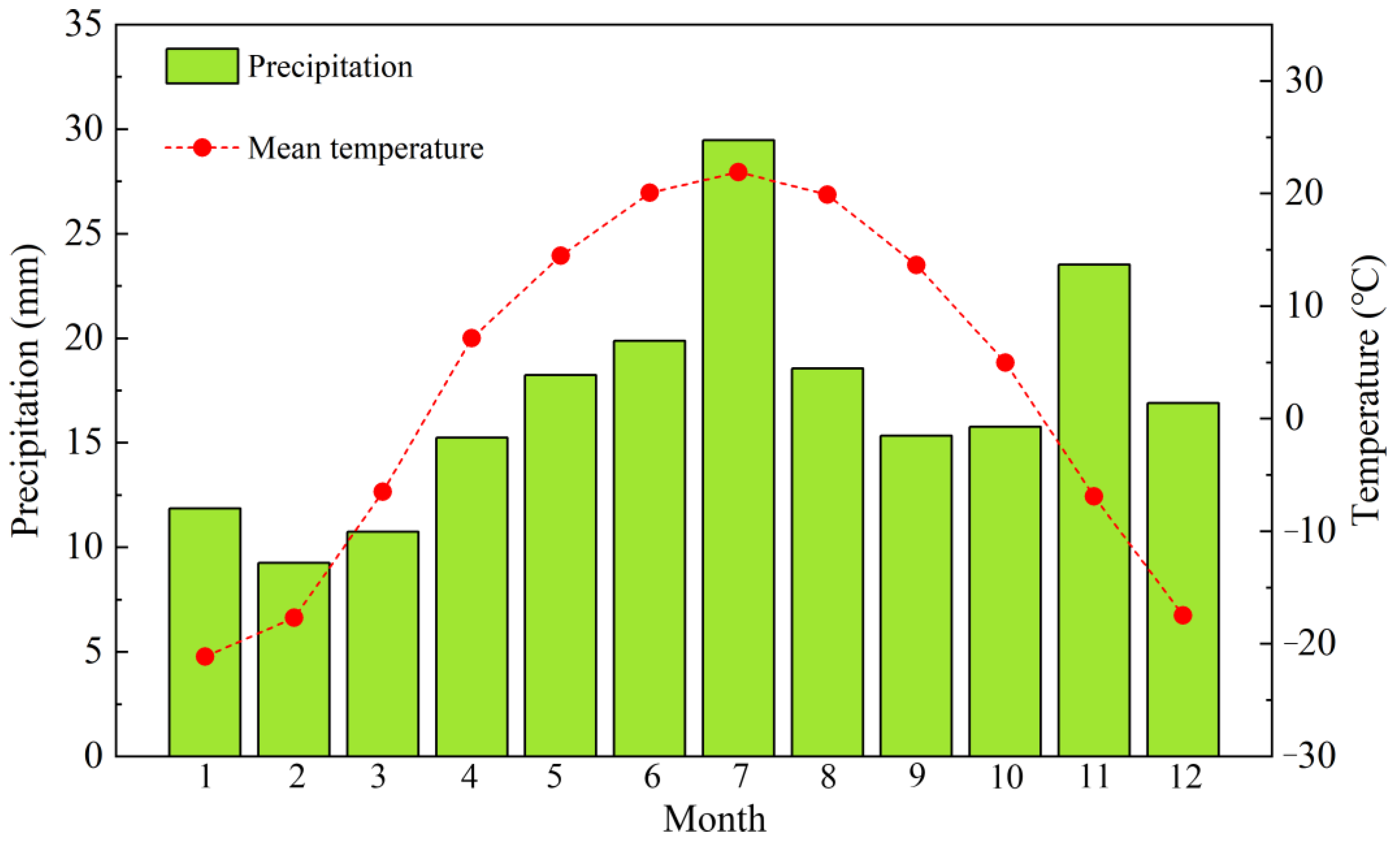
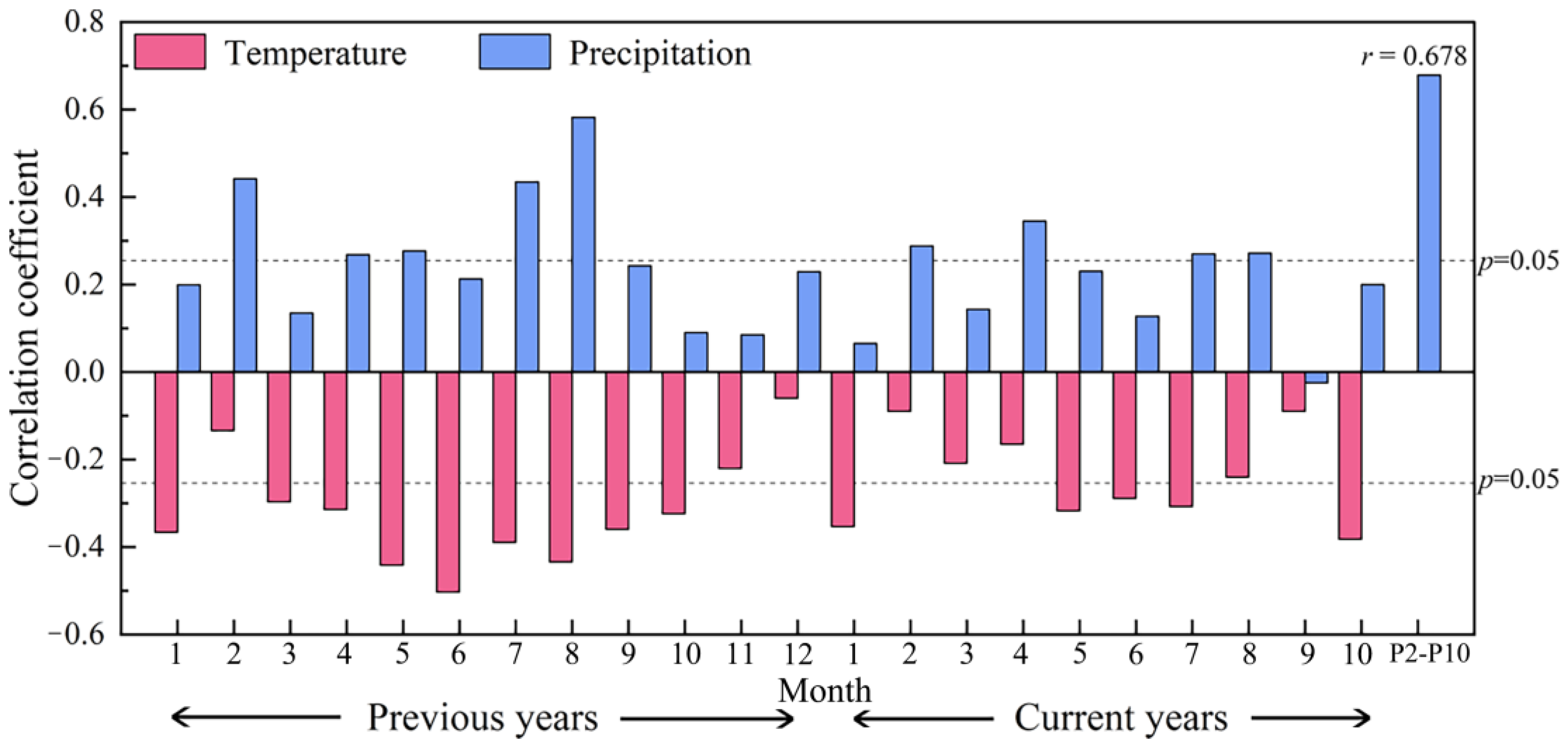
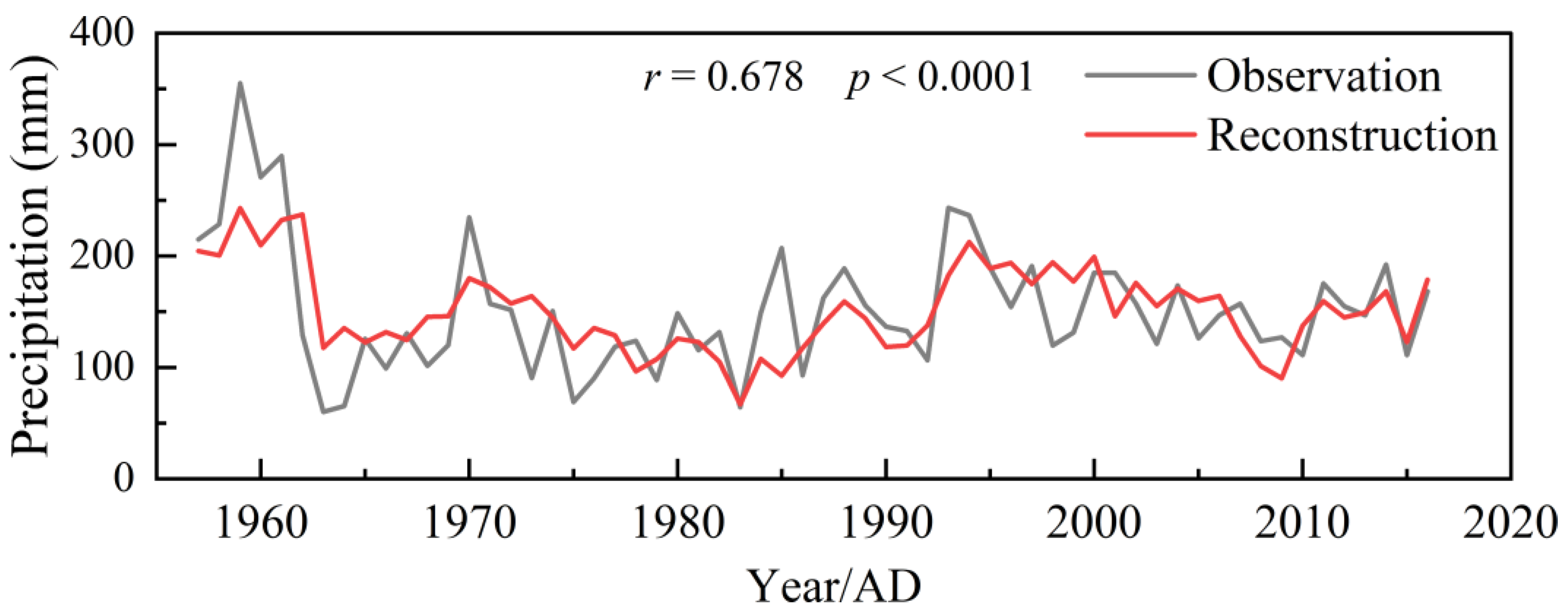
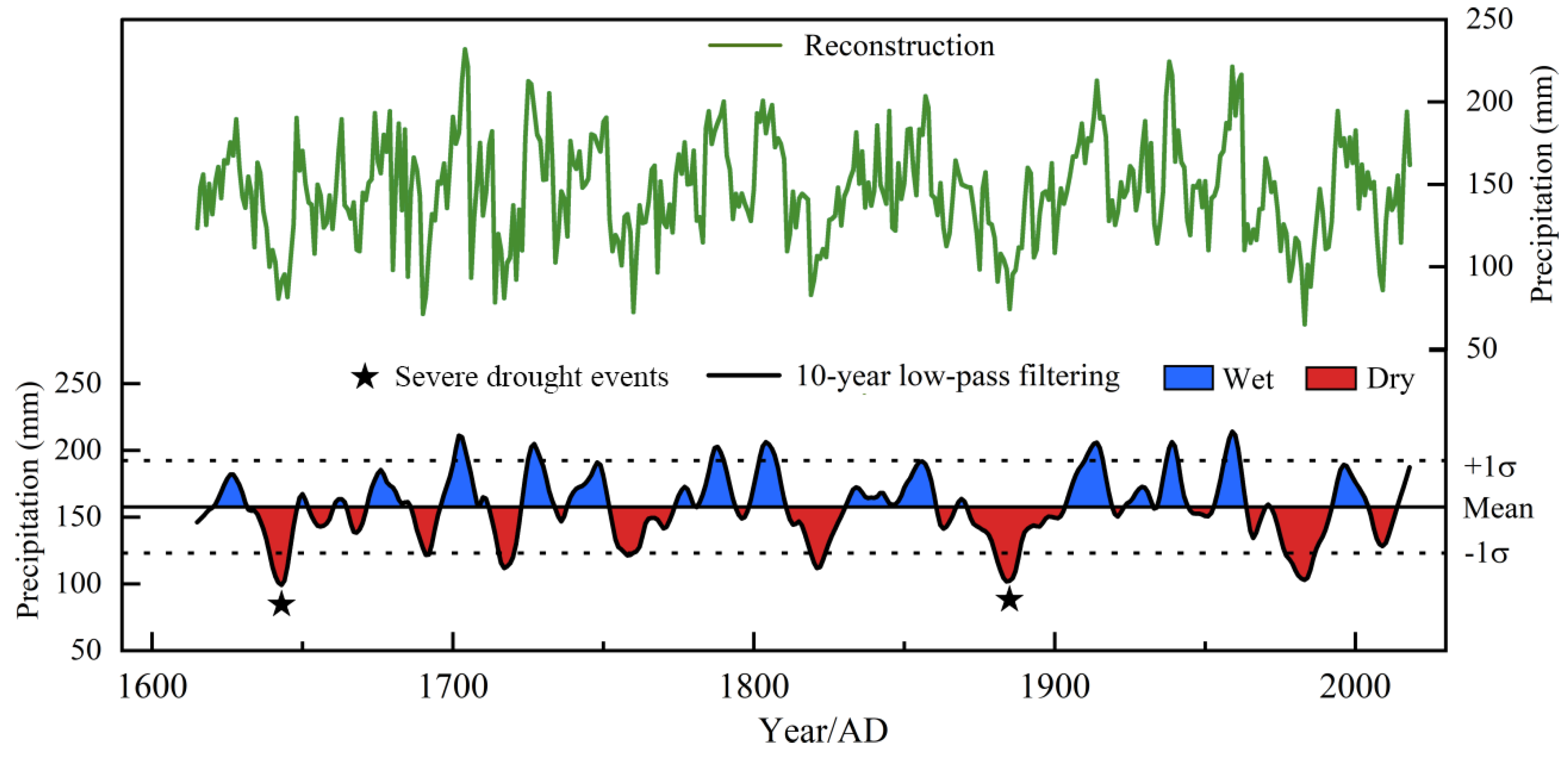


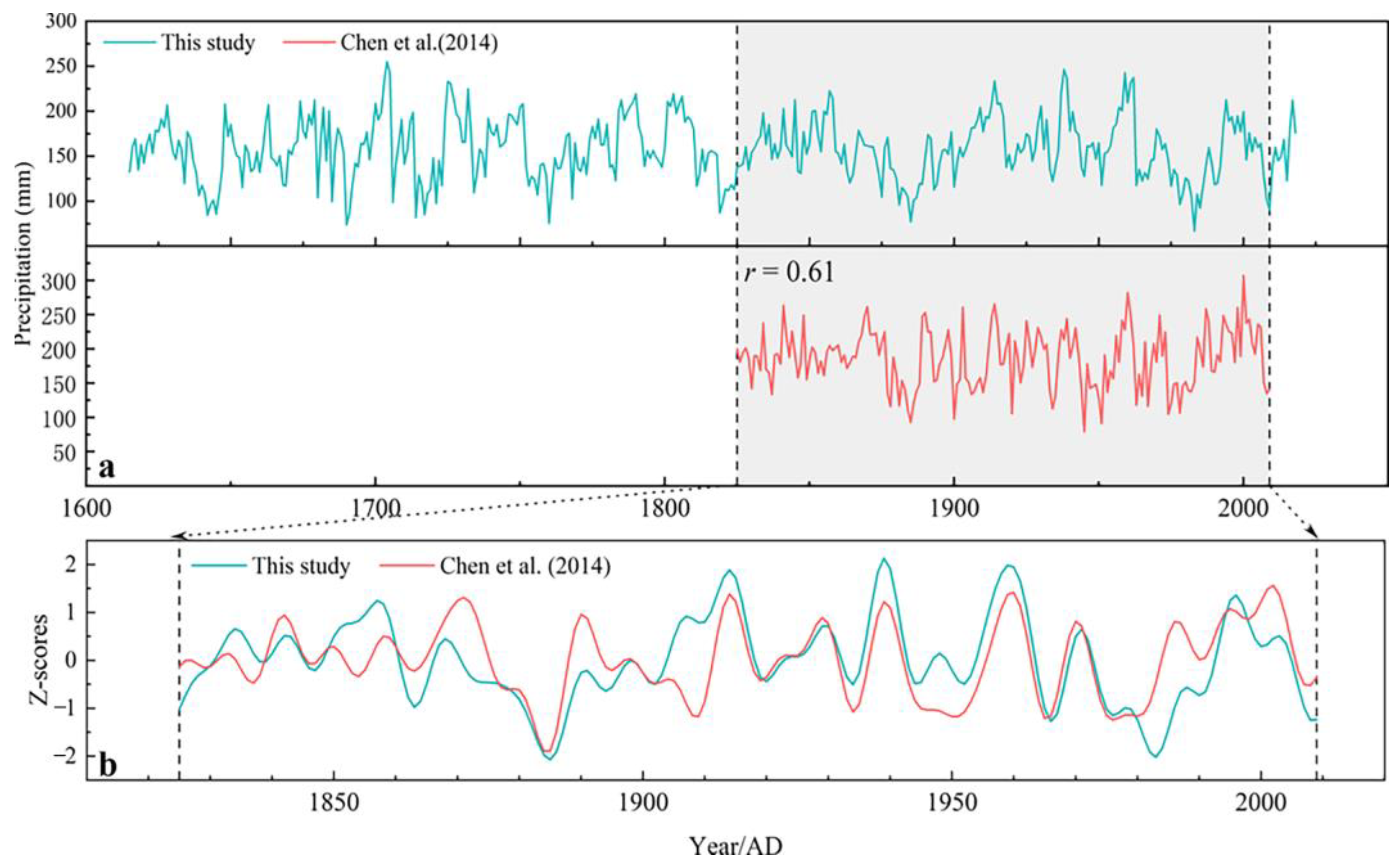

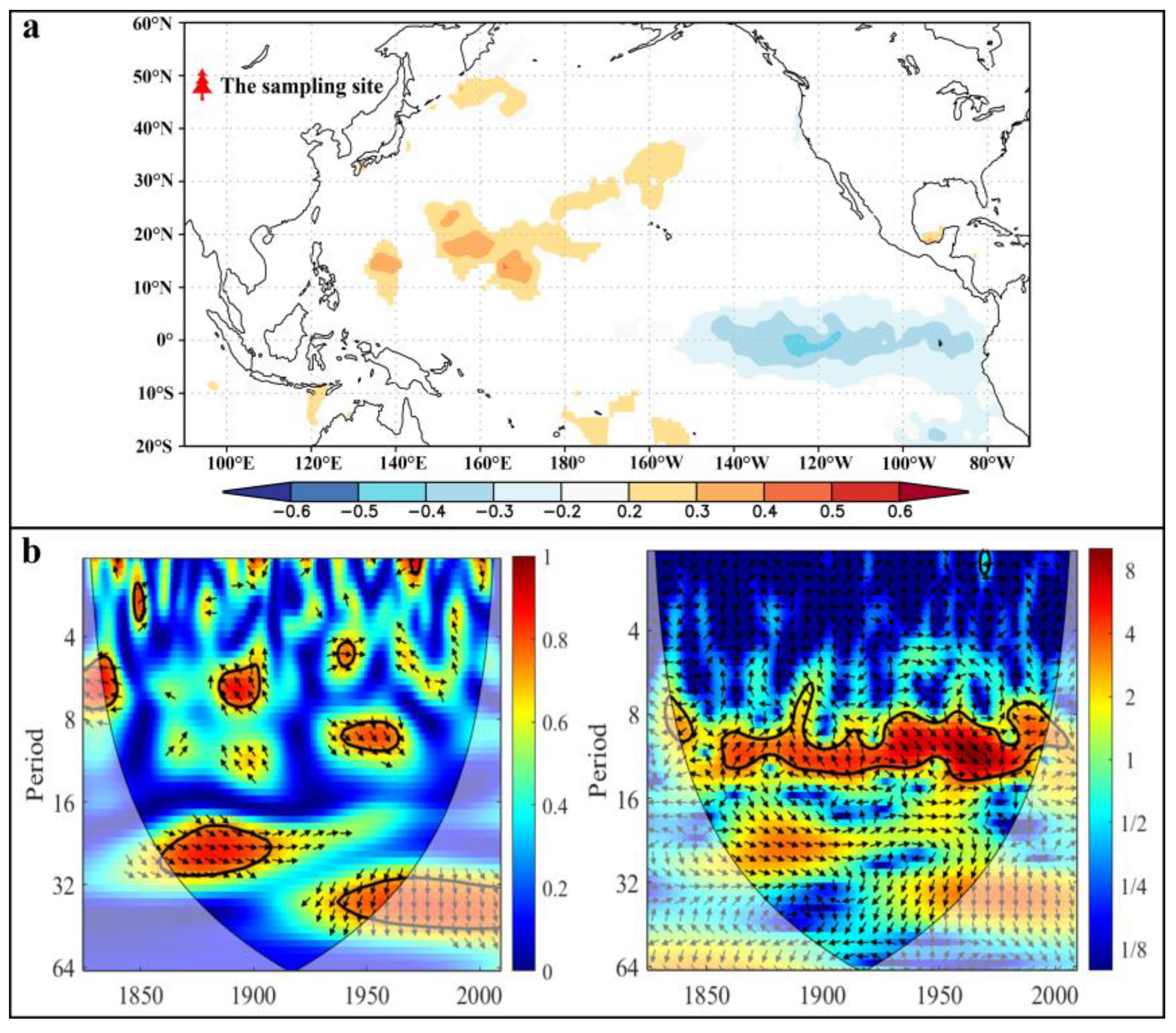
| Calibration | Verification | Calibration | Verification | Full Calibration | |
|---|---|---|---|---|---|
| (1957–1986) | (1957–1986) | (1987–2016) | (1987–2016) | (1957–2016) | |
| r | 0.713 | 0.713 | 0.576 | 0.576 | 0.678 |
| r2 | 0.508 | 0.508 | 0.331 | 0.331 | 0.459 |
| RE | 0.435 | 0.258 | |||
| CE | 0.421 | 0.179 | |||
| ST | 23+/7− | 22+/8− | 47+/13− |
Disclaimer/Publisher’s Note: The statements, opinions and data contained in all publications are solely those of the individual author(s) and contributor(s) and not of MDPI and/or the editor(s). MDPI and/or the editor(s) disclaim responsibility for any injury to people or property resulting from any ideas, methods, instructions or products referred to in the content. |
© 2023 by the authors. Licensee MDPI, Basel, Switzerland. This article is an open access article distributed under the terms and conditions of the Creative Commons Attribution (CC BY) license (https://creativecommons.org/licenses/by/4.0/).
Share and Cite
Pang, W.; Li, Q.; Liu, Y.; Song, H.; Sun, C.; Wang, J.; Yan, Y.; Cai, Q.; Ren, M. Precipitation Variations in China’s Altay Mountains Detected from Tree Rings Dating Back to AD 1615. Forests 2023, 14, 1496. https://doi.org/10.3390/f14071496
Pang W, Li Q, Liu Y, Song H, Sun C, Wang J, Yan Y, Cai Q, Ren M. Precipitation Variations in China’s Altay Mountains Detected from Tree Rings Dating Back to AD 1615. Forests. 2023; 14(7):1496. https://doi.org/10.3390/f14071496
Chicago/Turabian StylePang, Wenxuan, Qiang Li, Yu Liu, Huiming Song, Changfeng Sun, Jiachuan Wang, Yalan Yan, Qiufang Cai, and Meng Ren. 2023. "Precipitation Variations in China’s Altay Mountains Detected from Tree Rings Dating Back to AD 1615" Forests 14, no. 7: 1496. https://doi.org/10.3390/f14071496
APA StylePang, W., Li, Q., Liu, Y., Song, H., Sun, C., Wang, J., Yan, Y., Cai, Q., & Ren, M. (2023). Precipitation Variations in China’s Altay Mountains Detected from Tree Rings Dating Back to AD 1615. Forests, 14(7), 1496. https://doi.org/10.3390/f14071496








